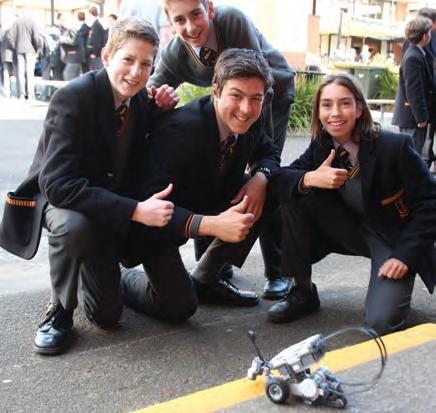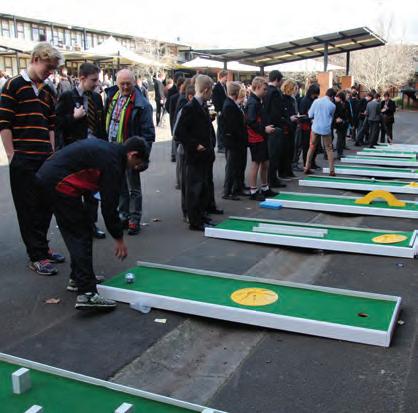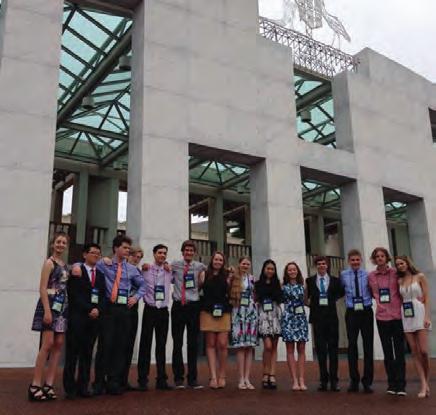
8 minute read
Science ___________________________________Pages
NATIONAL YOUTH SCIENCE FORUM
I had the pleasure of attending National Youth Science Forum from the 4 -16 January in Canberra at The Australian National University (ANU). The National Youth Science Forum (NYSF) program exceeded all my expectations by far. Each student was grouped with 13 other students in their selected area of interest in STEM (acronym for Science, Technology, Engineering and Mathematics). I was placed in the Chemistry group Curie, named in honour of Marie Curie - the physicist and chemist who pioneered research into radioactivity. Each group went on a range of lab visits that were in-line with their area of interest. For Curie, this was made up of a visit to a laboratory specially designed for dating rocks, the Cotter dam, the ACTEW water treatment plant, a pharmaceutical testing company, the molecular biology lab at the ANU’s John Curtin School of Medical Research and ANU’s chemistry lab. These lab visits were fascinating as they revealed aspects of STEM that I had never considered before. For example, during the lab visits to the JCSMR molecular biology lab and chemistry lab at ANU we performed titrations. These were exciting because we got the opportunity to see and use sophisticated lab technology. We had the chance to mix with esteemed and influential scientists at science dinners. One such scientist was Brian Schmidt, who received a Nobel Prize in Physics for providing evidence that the expansion of the universe is accelerating. Lectures and seminars were included amongst the lab visits and social events of the NYSF. These presentations covered topics such as entrepreneurship, critical thinking, approaching Year 12 and equality in science. I particularly enjoyed the lecture about approaching Year 12 as we received practical advice about studying whilst maintaining other aspects of your life, the type of mindset that is healthy to have as well as advice about what happens after Year 12. The National Youth Science Forum taught me new and amazing things about the scientific world, along with valuable life skills and aided my personal development. I met amazing people and made new friends during the forum. I will never forget my time at the NYSF.
Advertisement
- Matthew Oyang, Year 12
National Youth Science Forum was an amazing journey. Two hundred individuals came from across the globe for 2
incredible weeks to share in our passion for science. My group was specific to Engineering and most days consisted of visiting remarkable places around Canberra. This included giant telescopes and various industries such as Lockheed Martin and The Canberra Railway Museum. A highlight of the trip was a press conference to learn about the Large Hadron Collider in Germany. One of my favourite parts of the trip was the opportunity to visit Parliament House, receiving Mission to a grand tour, learning the depths of Australian Mars - Science Mars - Science Politics and how scientific issues are handled & Engineering in the system. There were 150 of us who did a Challenge mock Parliament where I was lucky enough to be the Prime Minister - Mr Turnbull! In debate we crushed the Labour and Greens on water, and then backed it up with a comfortable win in the votes 80-60. After which I was able to meet Mr Turnbull and discuss various parliamentary issues, including climate change, and Australia’s war on terror. Overall the trip was very worthwhile, and I highly recommend it to anyone with a passion for science, as the experience and knowledge they gain will be priceless!
- Benjamin Kenworthy, Year 12 SCIENCE & ENGINEERING CHALLENGE
On Thursday 28 April, 20 enthusiastic Year 10 Hovercraft - Science Hovercraft - Science students attended Deakin University for the 2016 & Engineering Science and Engineering Challenge. During the Challenge day the students competed against other schools to get hands-on with a variety of different activities Robots at including building bridges, wiring virtual cities, Science designing robotic hands and building a hovercraft. Week Week Whilst our boys were strong competitors, the St Joseph’s teams placed 4th overall. The students were also treated to a visit to the High Voltage Lab, a key facility within the CADET centre at Deakin, that dazzled all with tangible lightning bolts. The aim of the challenge was to give students access to activities they would not normally experience in schools and show them that STEM is an important part of their everyday life; something they should think about as a possible career in the future. - Nerrida Holland, Science Teacher
RACI TITRATION VICTORIAN SCHOOLS COMPETITION
Each year, the Royal Australian Chemical Institute Victorian Branch invites students from Years 10, 11 and 12 to compete in a titration competition. Students are required to apply
Benjamin Kenworthy Benjamin Kenworthy at the National Youth at the National Youth Science Forum Science Forum Matthew Oyang at the Matthew Oyang at the National Youth Science Forum National Youth Science Forum Science & Engineering Challenge
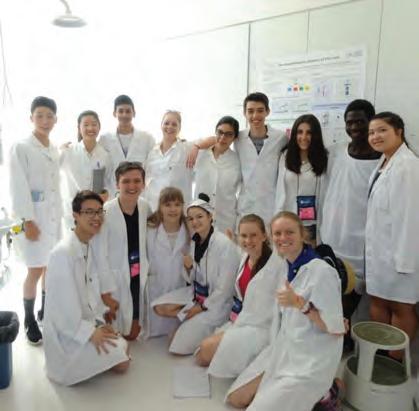
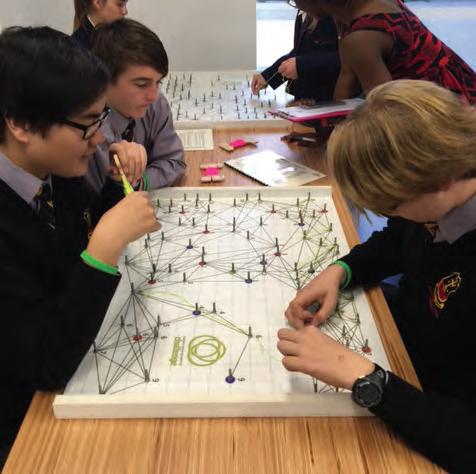
skills specific to chemistry which involves the use of pipettes and burettes, and calculate the concentration of an unknown solution. Teams consist of three students and this year St Joseph’s entered six teams, two at Year 10, three at Year 11 and one Year 12 team. These students gave up multiple lunch times in second term practising for the competition. This preparation ended with a 90 minute session to complete the titrations and calculations involved. All teams placed in the top 130, with four teams placing in the top 50, and two of these placing in the top 30. The teams who placed in the top 30 were invited to compete in the national competition. - Joanne Board, Science Teacher
NATIONAL SCIENCE WEEK 2016
National Science week is Australia’s annual celebration of science and technology. The schools theme for National Science week 2016 was ‘Drones, Droids and Robots’. St Joseph’s College celebrated this theme at the Edmund Rice campus on Thursday 18 August. From the start until the end of the day there were classes and groups of students visiting the activities set up to explore. Presenter Carl Ahlers aka Professor Bunsen presented during Periods 1 and 2 to a packed out auditorium made up of Year 7 and Year 8 classes, and Periods 3 and 4 to Year 9 students from the Westcourt campus. Students were awestruck by demonstrations of conversion of light to heat, sound to light and light to sound. Sound from an iPod was transmitted to a torch light beam. Electricity was converted to light and sound – AC/DC could be both seen and heard. Students’ imaginations were sent into overdrive when Professor Bunsen sent a student floating across the stage on a cushion of air. One of the biggest hits out in the Quadrangle were the Sphero robotic balls controlled with iPads on the nine hole mini golf course. There were some lolly bags up for grabs as reward for getting three holes in one or playing ‘Mary had a little lamb’, ‘hot cross buns’ or ‘Ode to joy’ on the stairs set up as a Makey Makey piano. Some students also presented and explained how the NXT robots they had built could follow a solid black line as an obstacle, move towards clapping sounds and draw circles with pens. These students constructed NXT robots over Term 2 during their lunchtimes. The Science domain at St Joseph’s hope our students enjoyed our interesting events and learnt something new about
the robots and drones available for entertainment, music and household tasks! So many were involved who helped make the day happen, including the 11 students who made NXT robots to display and present on the day, we are very appreciative of their input. We love taking science seriously!
- Michelle Anderson & Samantha O’Keeffe, Science Teachers YEAR 8 SCIENCE CULMINATING EVENT
On Thursday 15 September Year 8 students completed their Science Culminating Event for their Term 3 Project-based Learning unit as an Exhibition of Unicellular and Multicellular Organisms. For the Term students were tasked with tackling NXT the driving question ‘Explain why a large organism Robots such as a human requires systems to work together to respond to change compared to a singular cell/ unicellular organism?’ In groups of four, students had 10 weeks to learn about unicellular and multicellular organisms, PBL Science Expo focus on one human body system, plan, research and prepare three exhibition pieces to explain their answer to the above question. The exhibition pieces could range from a labelled, functional or food model of an organ or system, a poster supported by diagrams and photos, a laboratory report as evidence of their findings, a video or a PowerPoint. The presentations from the groups at the exhibition reflected students’ knowledge of surface area to volume ratio, and, structure and function of specialised tissues, organs and systems. They made comparisons between the singular cells or unicellular organisms to a body system and included theory on what might happen if something went wrong. There were guests from Deakin University Waurn Ponds School of Medicine, from Skilling the Bay Successful Student STEM project, and primary Makey Makeys at Makey Makeys at students from Clairvaux Primary School in National Science attendance to challenge the students on different Week Week levels with questions. Overall the exhibition was successful with students stepping up to the occasion presenting to people of a younger age, to adults in the field and people outside of their classrooms. This culminating event really gave students and teachers the real fruits of PBL. Well done to the entire Year level for their hard work and presentation skills.
- Samantha O’Keeffe, Science Domain Leader
Science Exhibition for PBL
